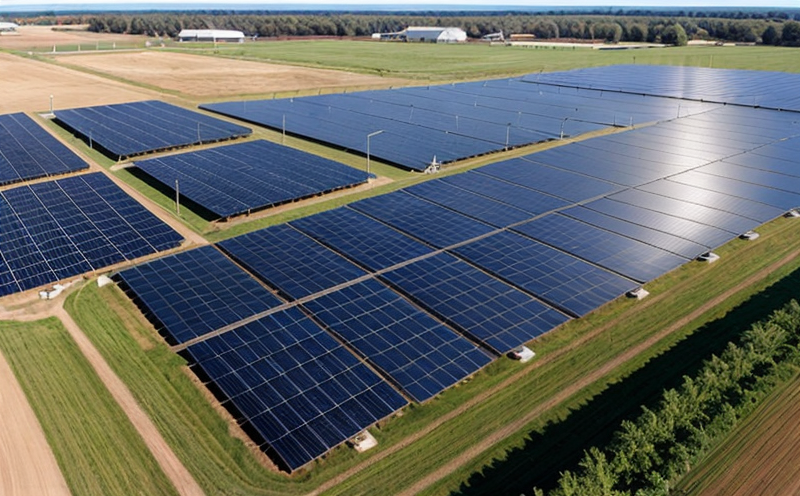UL 1699B Arc Fault Testing in Smart Inverters
The UL 1699B standard is a cornerstone for ensuring the safety of arc fault protection systems, especially within renewable energy technologies. This regulation specifically addresses the risk of electrical arcs and their potential to ignite fires or cause other hazards in smart inverters used in solar photovoltaic (PV) systems.
The testing process under UL 1699B involves a series of rigorous procedures aimed at simulating real-world conditions that could potentially trigger an arc fault. For smart inverters, this includes evaluating the device's ability to detect and mitigate arcs effectively. The standard covers various parameters such as current levels, voltage conditions, and environmental factors like temperature and humidity.
Smart inverters are critical components in modern PV systems, converting direct current (DC) from solar panels into alternating current (AC) for use in homes or businesses. Ensuring these devices comply with UL 1699B is essential to protect against dangerous situations that could arise due to faulty connections, insulation breakdowns, or other anomalies.
The testing procedure typically involves exposing the smart inverter to a controlled arc fault and monitoring its response. This includes checking for proper detection of the arc, appropriate suppression measures taken by the inverter, and ensuring no damage occurs to adjacent components or structures during the event. Compliance with this standard not only enhances safety but also helps manufacturers meet regulatory requirements and gain consumer trust.
One key aspect of UL 1699B testing is understanding how different variables like load conditions, ambient temperature, and humidity levels can affect arc fault detection and suppression performance. By simulating these environmental factors accurately during tests, laboratories ensure that the smart inverters perform reliably under various scenarios they might encounter in actual use.
The importance of accurate testing cannot be overstated; even slight variations in how these devices respond to an arc fault could have significant implications for safety. Therefore, it's crucial that both manufacturers and third-party testers adhere strictly to the guidelines provided by UL when conducting evaluations under this standard. This ensures consistent results across all tested products and fosters confidence among stakeholders regarding product quality.
Compliance with UL 1699B is particularly important for businesses operating in competitive markets where safety standards play a critical role in brand reputation. By demonstrating adherence to this stringent regulation, companies can differentiate themselves as leaders committed to producing safe and reliable products.
Why Choose This Test
Ensures compliance with international safety regulations, enhancing product reliability and reducing risks associated with arc faults in smart inverters.
Provides valuable insights into the performance of your product under controlled conditions that mimic real-world scenarios.
Gives manufacturers a competitive edge by demonstrating their commitment to quality assurance and safety standards.
By choosing UL 1699B arc fault testing, you are investing in the long-term success of your product. This test not only helps meet regulatory requirements but also builds customer confidence through proven safety measures. Additionally, it allows for continuous improvement based on feedback from rigorous testing processes.
Customer Impact and Satisfaction
Increased trust in the safety of smart inverters used within PV systems.
Mitigation of risks associated with arc faults, leading to improved product reliability and reduced liability issues for manufacturers.
Customers benefit greatly from products that have undergone thorough testing according to standards like UL 1699B. The peace of mind provided by knowing your smart inverter adheres strictly to these safety protocols can significantly enhance customer satisfaction levels. Furthermore, compliance with such stringent regulations often translates into better brand perception and higher sales volumes.
Use Cases and Application Examples
| Use Case | Description |
|---|---|
| Testing Smart Inverter Detection Capabilities | Evaluating the ability of smart inverters to detect arc faults accurately. |
| Analyzing Suppression Measures Taken by Inverters | Assessing whether the inverter suppresses an arc fault appropriately without causing further damage. |
| Evaluating Performance Under Various Conditions | Simulating different environmental factors such as temperature, humidity, and load conditions to ensure consistent performance. |
The UL 1699B arc fault testing covers a range of practical applications focused on ensuring the safety and reliability of smart inverters. These tests help identify potential weaknesses in design or manufacturing processes early on, allowing for necessary adjustments before mass production begins. This proactive approach ensures that only high-quality products reach end users, thereby enhancing overall customer satisfaction.





